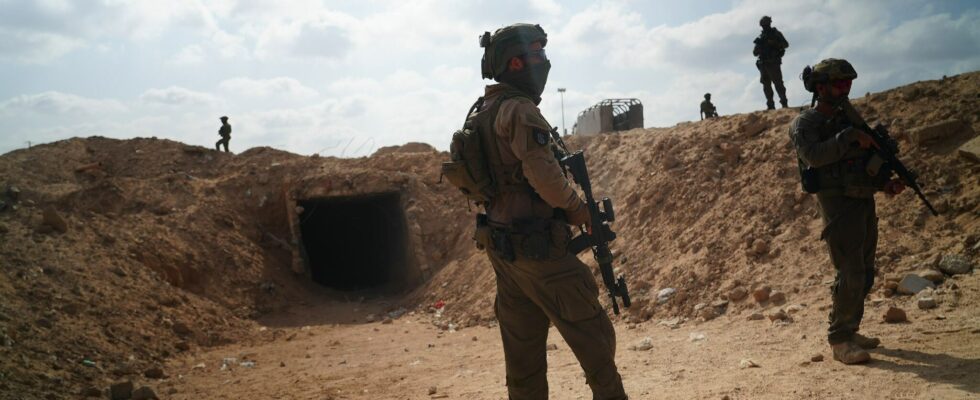This is yet another call for evacuation facing the population of Gaza: this Saturday, October 5, the Israeli army said it was preparing to act “with force” against Hamas in part of the center of the enclave. An announcement which comes as the IDF, although continuing its daily airstrikes on the Gaza Strip, had not launched a major raid for several weeks, focusing on clashes with Hezbollah on the Lebanese border, and on securing of the Philadelphia corridor, on the border with Egypt.
A year after the terrorist attacks of October 7 and the start of a conflict which left nearly 42,000 dead in Gaza (according to the latest report from the Hamas Ministry of Health), the Israeli army tirelessly pursues one of its main objectives: the destruction of Hamas military installations, hidden within a large and complex underground network of tunnels. But is she making progress? Months after the start of the ground offensive, and as the investigation by the Israeli services progresses, we know a little more about the way in which Hamas set about, during years of clandestinity, the construction of its underground facilities. And also how difficult it will be for the IDF to completely overcome it.
“The Gaza Metro”, still largely operational
In January 2024, Israeli defense officials estimated that the length of Hamas’ tunnel network, also called “the Gaza Metro,” was between 500 and 700 kilometers. “A staggering figure given that the enclave only has a total area of 360 square kilometers,” notes The Times of Israel. This summer, the Israeli daily revealed that the army was concerned that “after nine months of war, much of the network was still in good working order in many parts of Gaza”, and that the group had still the capacity to organize raids near the border with Israel, although not comparable to those of October 7. If the war were to end now, Hamas, which also rebuilt part of the tunnels struck by Israel, would still have the capacity to do harm, according to the newspaper.
Of course, the organization which had 35,000 soldiers before the war was greatly reduced. “The group lost its main political leader [NDLR : Ismaïl Haniyeh] as well as dozens of military commanders and around 15,000 fighters, according to regional intelligence officials,” summarizes The Washington Postin a long investigation published on the underground network of Gaza. “Stocks of money and weapons are dwindling. Many of the group’s approximately 5,700 tunnels have been destroyed by Israeli bombs,” he said.
But the hunt for fighters from the Islamic organization resembles an endless manhunt. “Israel Defense Forces officials described their dismay after digging their way into bunkers dozens of meters beneath Gaza’s streets, only to discover shafts leading to even deeper tunnels,” it said. the American daily. Although the IDF had long known of the threat posed by these tunnels, used by Hamas in 2006 to capture soldier Gilad Shalit, and Israeli forces had deployed sensors along the border, they had no idea of the size and the complexity of these tunnels.
A city beneath the city
Road and communication networks, weapons manufacturing workshops, provision storage, bomb shelters, field hospitals, housing (sometimes becoming hostage holding places): Hamas’ tunnels are a city beneath the city. “Despite years of Israeli blockade, the group managed to acquire an arsenal of rockets, explosives, light weapons, while building a financial and defensive network, allowing Hamas leaders to hold out for months, despite the headquarters of one of the most powerful armies in the world”, summarizes The Washington Post.
The network also operates relatively autonomously. To the surprise of American and Israeli intelligence, who believed that the majority of Hamas’ munitions were supplied by Iran, it was not assembly factories that were found in Gaza, but rather a multitude of small workshops. weapons factories buried a few meters deep, which a priori produce 80% of Hamas’s arsenal. Passing through the cracks of the Israeli blockade, the organization accumulated components from outside, as rudimentary as agricultural chemicals, intended for the manufacture of explosives.
A difficulty for Israel
Giving itself the means to achieve its ambitions, Hamas has collected tens of millions of dollars, from Iran and Qatar, but also thanks to local taxes and by diverting certain international aid, in order to finance the construction of this concrete labyrinth. , or even to pay Hamas fighters. Bank deposits were also stolen in the Gaza Strip after the start of the war.
This complex infrastructure, buried in the middle of civilian installations, gives the regular Israeli army a hard time. “Fighting an enemy capable of moving horizontally and vertically, on a battlefield located in a highly populated urban area, constitutes a formidable military challenge,” explains Dana Stroul, assistant secretary of defense for the Middle East during the three early years of the Biden administration. A defense official also told the Times of Israel “that dismantling the tunnels could take years. He said the underground passages must be mapped and checked for booby traps and hostages before Israeli forces can destroy them.”
Another major problem for Israel: a second military network, that of Hezbollah this time. This summer, the Shiite militia, probably in order to send a strong message to the Jewish state, published information indicating the extent of its underground operations in Lebanon. In the released footage, Hezbollah members are shown moving through a maze of lit tunnels, with vehicles carrying weapons. The leader of the group, Hassan Nasrallah, who has since died, talks about the possession of precision missiles, thereby setting the stage for a potentially violent response in the event of Israeli aggression.
At the time, military analyst Hisham Jaber, a retired Lebanese general, explained to AFP that little was known about Hezbollah’s “top secret” bunkers and tunnels. “Warplanes cannot reach these facilities […] and fighters could stay inside well-stocked tunnels for months.” Israel could actually “continue destroying Lebanon for months without ever reaching” the bunkers, he added.
